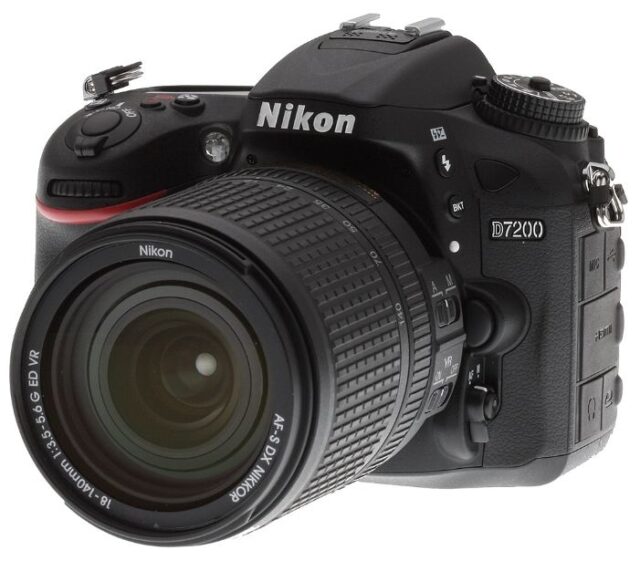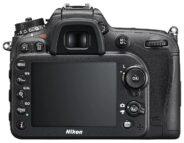Announced
Production status
System
Nikon F APS-C system cameras
- Nikon D1
- Nikon D100
- Nikon D1H
- Nikon D1X
- Nikon D200
- Nikon D2H
- Nikon D2Hs
- Nikon D2X
- Nikon D2Xs
- Nikon D300
- Nikon D3000
- Nikon D300s
- Nikon D3100
- Nikon D3200
- Nikon D3300
- Nikon D3400
- Nikon D3500
- Nikon D40
- Nikon D40X
- Nikon D50
- Nikon D500
- Nikon D5000
- Nikon D5100
- Nikon D5200
- Nikon D5300
- Nikon D5500
- Nikon D5600
- Nikon D60
- Nikon D70
- Nikon D7000
- Nikon D70s
- Nikon D7100
- Nikon D7200
- Nikon D7500
- Nikon D80
- Nikon D90
Nikon D7200
APS-C AF digital SLR camera • Discontinued
Specification
| Format: | |
| APS-C | |
Imaging sensor: | 23.5 × 15.6mm CMOS sensor |
Resolution: | 6000 × 4000 - 24 MP |
Crop factor: | 1.53x |
Sensor-shift image stabilization: | - |
| Nikon F [46.5mm] | |
| Shutter: | |
Type: | Focal-plane |
Model: | Electronically controlled |
Speeds: | 30 - 1/8000 + B |
| Exposure: | |
Exposure metering: | Through-the-lens (TTL), open-aperture |
Exposure modes: | Programmed Auto |
| Aperture-priority Auto | |
| Shutter-priority Auto | |
| Manual | |
| Physical characteristics: | |
Weight: | 755g |
Dimensions: | 135.5x106.5x76mm |
Manufacturer description
MELVILLE, NY (March 1, 2015 at 11:01 P.M. EST) - Today, Nikon Inc. introduced the Nikon D7200, a powerful DX-format DSLR built for enthusiasts ready to conquer the next challenge in their photographic journey. Featuring a 24.2-megapixel CMOS sensor with no optical low-pass filter (OLPF) and the EXPEED 4 image processing system, the D7200 is capable of incredibly fast performance and capturing phenomenally detailed, sharp images and HD video. Nikon’s newest lightweight DSLR also adds increased buffer capacity compared to the D7100, includes new Picture Controls and offers the experience of Nikon Snapbridge, whereby users seamlessly shoot and share stunning photos from the camera to a compatible smartphone or tablet via built-in Wi-Fi®1 and Near Field Communication (NFC2). Additionally, Nikon introduced the new ME-W1 wireless microphone, a simple solution to DSLR videographers’ wireless sound needs, as well as the new View NX-i imaging software.
“Those passionate about photography are constantly looking for the next challenge and Nikon is committed to providing the tools necessary to take that passion to the next level,” said Masahiro Horie, Director of Marketing and Planning, Nikon Inc. “The new DX-format Nikon D7200 offers the next level of performance for the enthusiast photographer that wants to creatively capture exceptional images and HD video that can be easily shared with friends and family.”
Incredible Image Quality
Nikon’s newest DSLR features a powerful 24.2-megapixel DX-format CMOS sensor with no OLPF capable of producing stunning images and maximum sharpness in nearly any shooting scenario. Combined with the new EXPEED 4 Image Processing engine, the Nikon D7200 renders sharp images and HD video with wide dynamic range, with the added benefit of extremely precise autofocus and metering. Whether on assignment or photographing the next family gathering, the D7200 is the ideal tool to capture important moments with incredible quality. For when available light is scarce, the camera also features a wide ISO range from 100-25,600 to help minimize noise in low-light situations. As always, the Nikon D7200 maintains compatibility with the legendary line of NIKKOR lenses and DSLR accessories which adds even more reach and versatility to any photographer’s kit.
Powerful Performance for Serious Photographers
Enthusiast photographers need a DSLR that can keep up with their passions. The Nikon D7200 sports a host of features designed to provide the power and precision needed to take on the next photographic challenge. Courtesy of EXPEED 4, the D7200 features 30% faster image processing than its predecessor, the Nikon D7100, and provides an increased buffer capacity that now allows the camera to shoot 18 consecutive RAW 14-bit lossless compressed images, 27 12-bit compressed shots or 100 JPEG frames. Additionally, this powerful DX-format DSLR offers users the versatility to shoot at 6 frames-per-second (fps) continuously or up to 7 fps in 1.3x crop mode, a popular shooting mode for both sports and wildlife photographers.
Photographers in need of a versatile, powerful yet lightweight DX-format DSLR need look no further than the Nikon D7200. When shooting fleeting moments or fast action, photographers will appreciate the camera’s pro-caliber 51-point autofocus array powered by a new Advanced Multi-CAM 3500II DX high-density system. The AF points cover a wide DX-format area, and nearly the entire frame using 1.3x crop mode. Even in low-light, the D7200 utilizes 15 cross-type sensors to achieve incredible focus on moving subjects, while the center point works down to f/8, making it great for use with compatible teleconverters. The Nikon D7200 also features a 2,016 RGB metering sensor alongside Nikon’s Scene Recognition System to help achieve the perfect exposure and focus in a variety of shooting scenarios.
Create, Capture and Share with Incredible Versatility
The Nikon D7200 is the first Nikon DSLR to feature both built-in Wi-Fi®1 and NFC2 that allow for seamless connectivity and sharing via compatible smart devices. Via NFC, users can simply touch their device to the camera for easy connectivity, while built-in Wi-Fi also allows the user to utilize their smartphone for simple playback and sharing, as well as a remote shutter and monitor.
In addition to robust performance and incredible image quality, the D7200 also sports a feature set designed to foster creativity in any level of photographer. Nikon’s newest DX-format DSLR features the next generation of Picture Controls, now including Flat and Clarity settings, to help users craft each individual image to their intended expression. These controls have been expanded for use in Live View, while artistic effects can be applied to both stills and video in real time, offering the user the ultimate in creative control. Ergonomically designed and ready to endure the elements, the Nikon D7200 features a durable yet lightweight magnesium alloy body and is ready to tackle the next photographic challenge. Users can also take advantage of a 3.2-inch ultra high-resolution (1,229k dot) LCD monitor and a low-power consumption organic EL (OLED) display element in the optical viewfinder that improves visibility when shooting.
Impressive Video Capabilities
The Nikon D7200 inherits many of the high-end video capabilities of Nikon’s latest full frame DSLRs, the Nikon D810 and Nikon D750. Ready to capture top-quality HD video at a moment’s notice, users can take advantage of a robust video feature set that allows videographers to record uncompressed and compressed Full HD 1080 footage at 30/25/24p and 1080 at 60/50p in 1.3x Crop Mode. Additionally, Auto ISO sensitivity is now available in manual mode, helping create smooth exposure transitions without changing shutter speed or aperture, while “zebra stripes” highlight display is available to confirm exposure. Video controls are available through a dedicated movie menu for quick access, while aspiring videographers can also utilize a built-in stereo microphone with 20 step adjustments to record smooth DSLR audio. The D7200 is also the first Nikon DX-format DSLR to feature a built-in Time Lapse Mode with exposure smoothing, making capturing a beautiful sunset time-lapse easier than ever.
ME-W1: A Simple Solution to Wireless Sound in DSLR Video
Nikon has also introduced a versatile new wireless lavalier microphone for Nikon users, the ME-W1, capable of capturing crisp and detailed audio wirelessly. Weather resistant and powered by two AAA batteries, users can wirelessly record audio in mono or stereo (when connected to the ME-1 stereo microphone) from up to 50m (164 ft.) away. Great for bloggers, aspiring videographers or even professionals, the ME-W1 makes recording audio for DSLR video simple, without sacrificing quality sound.
View NX-i: New, Innovative Software for Photographers
For photographers that wish to take control of their images after capture, Nikon also announces new View NX-i browsing software that allows for more intuitive control of images than ever before. View NX-i allows users to browse RAW files adjusted by Capture NX-D software and provides the easy upload of images to social networks.
Similar cameras (4)
APS-C • Auto focus • Digital • Singe-lens reflex • Nikon F mount
| Model | Shutter | Metering | Modes | Year |
|---|---|---|---|---|
| Fujifilm FinePix S1 Pro | E, 1/2000 | TTL • OA | PASM | 2000 ● |
| Fujifilm FinePix S2 Pro | E, 1/4000 | TTL • OA | PASM | 2002 ● |
| Fujifilm FinePix S3 Pro | E, 1/4000 | TTL • OA | PASM | 2004 ● |
| Fujifilm FinePix S5 Pro | E, 1/8000 | TTL • OA | PASM | 2006 ● |

